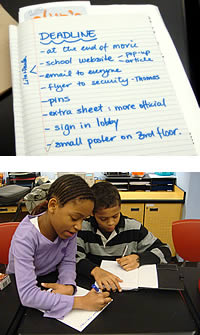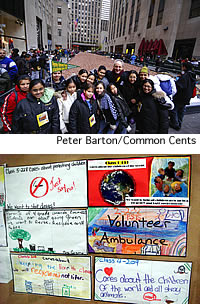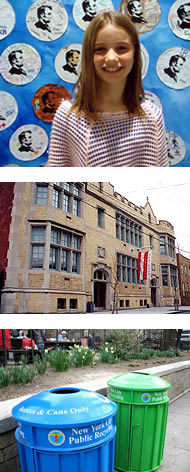
Photo: Peter Barton/Common Cents
by Barbara Cervone
NEW YORK, NY—A few weeks shy of Thanksgiving, Deanna Belcher’s sixth-grade class at The School at Columbia University bursts with nervous energy. “Our deadline is just two weeks away,” the teacher says. “We’ve set ourselves a huge goal: to collect one hundred and fifteen sacks of pennies—3,450 pounds! How are we going to get people to help?” 
Hands fly up and students hop up from their seats with ideas. “Let’s make a flyer for teachers to pass out in class.” “Let’s write the public library and ask them to put out a collection box.” “Let’s put an article in Lion’s Share [the school’s e-newsletter to families].” “Let’s make more posters and put them up all over the school.”
“You know how they pass out pamphlets on the street?” calls a voice from the corner of the room. “We could create a pamphlet with the school’s address, and have a collection box in front of the school.”
“But people would steal it!” several students interrupt.
“Okay, let’s focus on the strategies we can get done right now, today,” the teacher says. “Flyers, posters, a letter to the library, an article for tomorrow’s newsletter. Let’s break into teams and get going!”
These sixth graders are “Penny Harvesters” for Common Cents, a New York City initiative that since 1991 has turned loose change collected from friends, family, and neighbors into grants totaling $6.8 million. By Thanksgiving—along with half a million children across the city—they will hand in their pennies, and during the winter they will award grants that range from supporting a local soup kitchen to saving endangered animals six thousand miles away.
Penny power
Common Cents grew from the desire of a four-year-old—co-founder Nora Gross—to help a homeless man, and from the willingness of her father, Teddy Gross, to take her longing and multiply it by a million. Its signature program, the Penny Harvest, is now the largest child philanthropy program in the United States. In 2007, the pennies gathered by New York City students filled a pedestrian walkway at Rockefeller Center, creating a “Penny Field” of a million pennies, give or take a few.
“Penny power, that’s what I call it,” says Judy, age ten.
The Penny Harvest has four parts. Each fall students in as many as 1,000 schools across New York City, led by a teacher “coach” trained by Common Cents, take their campaign to classmates, the apartment buildings where they live, a corner store, the local library, a parent’s workplace—wherever their personal networks carry them. Executive Director Gross calls it “collection with connections.” Like Deanna Belcher’s class, the youth bring gusto to their drive, striving to help their school beat the “25 Sack Challenge” by filling 25 sacks of pennies, which equals 750 pounds and $1,000.
In the second phase, students make grants from the pennies they have raised. A “Philanthropy Roundtable” at each school, made up of students, conducts a school-wide vote to determine which causes most attract students. On a “Wall of Caring” in the school hallway, students can write about the issues that stir them. With this information in hand, the roundtable group researches nonprofits that address their chosen causes, then selects one or two for grant awards.
Students often take their philanthropy a step further, creating a service project in their own neighborhood. Some have helped paint a local recreation center; others have taught English to new immigrants. In 2007, students carried out 345 community service projects, on top of awarding 1,513 monetary grants.
Finally, when they have presented their checks and completed their projects, Penny Harvesters celebrate with a party and reflect on what they have accomplished. “We give ourselves a small hand and a big pizza,” eleven-year-old Thomas says with a grin.
Decisions that make a difference
While many charities involve children in the collection of funds, the roundtables at Common Cents stand out for giving students authority to allocate the money they raise. “We give the youngest people the chance to see problems and ask questions,” says co-founder Nora Gross. “And then they answer them with the creativity, sensitivity, and generosity that comes so naturally to children.” 
Ten-year-old Kayla, a three-year veteran Penny Harvester at The School at Columbia University, would agree. “Gathering the pennies is fun—you have to motivate people and that’s exciting,” she says. “Being on the roundtable is serious. You have to study the problems, research, discuss and debate. You get to make really important decisions, decisions that help life, that help keep the planet going.”
At P.S. 15 in Red Hook, Brooklyn, a group of fifth graders, coaxed by their teacher Julie Cavanaugh, talk about their experiences serving on their school’s Philanthropy Roundtable. After polling classmates and interviewing teachers and parents, they decided to focus on the environment. Looking around the neighborhood, they found the Red Hook Community Justice Center, which yearned to plant flowers around trees on the sidewalk in front of their building. The staff at the justice center came to the school to present its case and students decided to award them $200. A group of teens in the community volunteered to plant the flowers.
With the remaining $800, the Red Hook students organized three successive “green festivals”—one in their schoolyard, one across from the local public library, and a third at a nearby park. They created informational stations on topics from conserving water to recycling, and researched flyers to pass out on “Ten Ways to Stop Global Warming.”
“Once people know some of the facts, they may change their ways,” one student comments. “You wouldn’t believe how much water you waste when you leave the faucet running while you brush your teeth.”
They also created environmental information kits for every teacher at their school and planted a peace garden at the school entrance.
“It feels so good to be our age and make a difference, especially when it comes to the environment,” a Red Hook student says. “Planting flowers, recycling trash—it adds up, I think.”
A new generation that cares
At Common Cents, the energetic contributions of Penny Harvesters add up to more than spreading charity and goodwill, however powerful these are. Along the way, students also learn important lessons about compassion, compromise, responsibility, and the value of giving back.
“If you start out early as a kid, it stays with you all your life,” explains Christian, a fourth grader. “Helping people, it just sticks with you, because once you get it inside you, it really stays inside you.”
A recent Columbia University study of 200 teachers involved in the program confirms the short-term and potentially lasting impacts on students like Christian. The program’s steady spread also underscores its success. More than 70 percent of New York City schools now participate, with new schools joining each year. Common Cents now has offices in the Capital Region of New York as well as in Colorado, Florida, and Seattle.
Penny Harvesters bring a youthful directness to their work. “When nonprofit CEOs in suits come to a school to be interviewed by students,” says Maggie Jacoby, External Relations Manager at Common Cents, “the kids have no problem asking them tough questions like, ‘What do you spend on overhead? How much of your revenues go to direct help?’”
Students also see things adults might miss, Jacoby notes, and they devise simple solutions. They gave foster children duffel bags, to replace the garbage bags stuffed with belongings at moving time. They created a children’s corner in a busy emergency room, where children awaiting for treatment for an asthma attack may find calm.
“In the beginning, a lot of the kids were like, ‘What are we going to do? How are we going to make a difference? We’re just twenty kids!’” remembers Julia, the veteran Penny Harvester. In the end, like students across the city, her group learned how two small denominations—pennies and kids—could together make big change.




